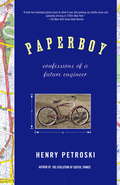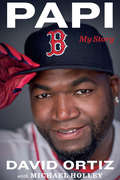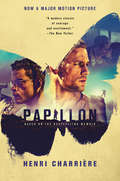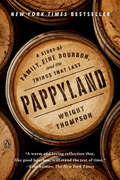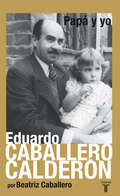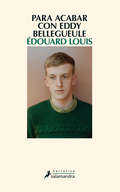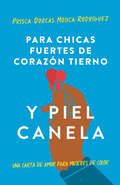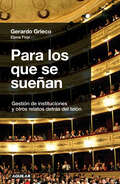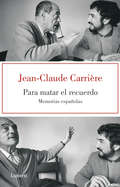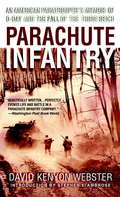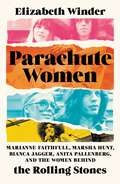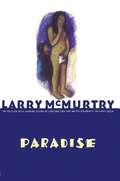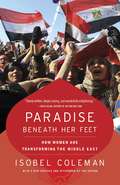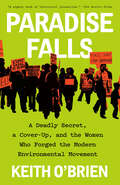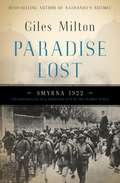- Table View
- List View
Paper Trails: From the Backwoods to the Front Page, a Life in Stories
by Roy MacGregorOne of Canada's greatest journalists shares a half century of the stories behind the stories.From his vantage point harnessed to a tree overlooking the town of Huntsville (he tended to wander), a very young Roy MacGregor got in the habit of watching people—what they did, who they talked to, where they went. He has been getting to know his fellow Canadians and telling us all about them ever since. From his early days in the pages of Maclean's, to stints at the Toronto Star, Ottawa Citizen, National Post and most famously from his perch on page two of the Globe and Mail, MacGregor was one of the country's must-read journalists. While news media were leaning increasingly right or left, he always leaned north, his curiosity trained by the deep woods and cold lakes of Algonquin Park to share stories from Canada's farthest reaches, even as he worked in the newsrooms of its southern capitols. From Parliament to the backyard rink, subarctic shores to prairie expanses, MacGregor shaped the way Canadians saw and thought about themselves—never entirely untethered from the land and its history. When MacGregor was still a young editor at Maclean's, the 21-year-old chief of the Waskaganish (aka Rupert's House) Crees, Billy Diamond, found in Roy a willing listener as the chief was appealing desperately to newsrooms across Ottawa, trying to bring attention to the tainted-water emergency in his community. Where other journalists had shrugged off Diamond's appeals, MacGregor got on a tiny plane into northern Quebec. From there began a long friendship that would one day lead MacGregor to a Winnipeg secret location with Elijah Harper and his advisors, a host of the most influential Indigenous leaders in Canada, as the Manitoba MPP contemplated the Charlottetown Accord and a vote that could shatter what seemed at the time the country's last chance to save Confederation. This was the sort of exclusive access to vital Canadian stories that Roy MacGregor always seemed to secure. And as his ardent fans will discover, the observant small-town boy turned pre-eminent journalist put his rare vantage point to exceptional use. Filled with reminiscences of an age when Canadian newsrooms were populated by outsized characters, outright rogues and passionate practitioners, the unputdownable Paper Trails is a must-read account of a life lived in stories.
Paperboy: Confessions of a Future Engineer
by Henry PetroskiHenry Petroski has been called "the poet laureate of technology." He is one of the most eloquent and inquisitive science and engineering writers of our time, illuminating with new clarity such familiar objects as pencils, books, and bridges. In Paperboy, he turns his intellectual curiosity inward, on his own past. Petroski grew up in the Cambria Heights section of New York City's borough of Queens during the 1950s, in the midst of a close and loving family. Educated at local Catholic schools, he worked as a delivery boy for the Long Island Press. The job taught him lessons about diligence, labor, commitment, and community-mindedness, lessons that this successful student could not learn at school. From his vantage point as a professor, engineer, and writer, Petroski reflects fondly on these lessons, and on his near-idyllic boyhood. Paperboy is also the story of the intellectual maturation of an engineer. Petroski's curiosity about how things work--from bicycles to Press-books to newspaper delivery routes--was evident even in his youth. He writes with clear-eyed passion about the physical surroundings of his world, the same attitude he has brought to examining the quotidian objects of our world. Paperboy is a delightful memoir, telling the dual story of an admirable family in a more innocent, bygone America, and the making of an engineer and writer. This is a book to cherish and reread.
Papi: My Story
by David Ortiz Michael HolleyThe Red Sox Hall of Famer and World Series MVP tells the story of his life and career in a sports memoir that &“lives up to its &‘no-holds-barred&’ billing&” (Washington Post). David &“Big Papi&” Ortiz is a baseball icon and one of the most popular figures ever to play the game. A star player with the Boston Red Sox for fifteen years, Ortiz helped to win three World Series, bringing back a storied franchise from &“never wins&” to &“always wins.&” As he launched balls into the stands again and again, he helped silence the naysayers while capturing the imaginations of millions of fans. Ortiz made Boston and the Red Sox his home, his place of work, and his legacy. In Papi, Ortiz tells his story in his own words, opening up as never before. The result is a revelatory tale of a storied career—all told by a legendary player with a lot to say at the end of his time in the game. This edition of Papi includes a new afterword. &“Baseball fans of all loyalties will enjoy learning about [Ortiz&’s] unique experiences in and out of the game.&” —Library Journal &“The rise of Ortiz from scrap-heap bench player to Hall of Famer is an unlikely and entertaining story, and engagingly told.&” —Washington Post
Papillon
by Henri CharriereHenri CharriÈre, called "Papillon," for the butterfly tattoo on his chest, was convicted in Paris in 1931 of a murder he did not commit. Sentenced to life imprisonment in the penal colony of French Guiana, he became obsessed with one goal: escape. After planning and executing a series of treacherous yet failed attempts over many years, he was eventually sent to the notorious prison, Devil's Island, a place from which no one had ever escaped . . . until Papillon. His flight to freedom remains one of the most incredible feats of human cunning, will, and endurance ever undertaken. CharriÈre's astonishing autobiography, Papillon, was published in France to instant acclaim in 1968, more than twenty years after his final escape. Since then, it has become a treasured classic -- the gripping, shocking, ultimately uplifting odyssey of an innocent man who would not be defeated.
Papillon
by Henri CharrièreUn clásico autobiográfico que relata la increíble evasión de un hombre que vivió una auténtica odisea por perseguir aquello que nunca debió perder: la libertad. <P><P>En 1931, Henri Charrière, apodado Papillon por el tatuaje en forma de mariposa de su pecho, fue condenado a prisión por un asesinato que no había cometido. Sentenciado a cadena perpetua en una colonia penal de la Guayana Francesa, en su mente solo cabía una meta: escapar. <P>Tras varios intentos fallidos de fuga a lo largo de los años, fue enviado a la llamada Isla del Diablo, de donde ningún recluso se había evadido jamás... hasta su llegada. <P>La lucha por la libertad de Papillon sigue siendo una de las más increíbles hazañas que el ingenio, el tesón y la valentía humanos hayan demostrado jamás. Su relato dio lugar a esta extraordinaria autobiografía, la odisea de un hombre inocente para perseguir lo que nunca debió perder: la libertad.
Papillon
by Henri CharrièreUn clásico autobiográfico que relata la increíble evasión de un hombre que vivió una auténtica odisea por perseguir aquello que nunca debió perder: la libertad. En 1931, Henri Charrière, apodado Papillon por el tatuaje en forma de mariposa de su pecho, fue condenado a prisión por un asesinato que no había cometido. Sentenciado a cadena perpetua en una colonia penal de la Guayana Francesa, en su mente solo cabía una meta: escapar. Tras varios intentos fallidos de fuga a lo largo de los años, fue enviado a la llamada Isla del Diablo, de donde ningún recluso se había evadido jamás... hasta su llegada. La lucha por la libertad de Papillon sigue siendo una de las más increíbles hazañas que el ingenio, el tesón y la valentía humanos hayan demostrado jamás. Su relato dio lugar a esta extraordinaria autobiografía, la odisea de un hombre inocente para perseguir lo que nunca debió perder: la libertad. Reseñas:«La mayor hazaña de todos los tiempos.»Auguste Le Breton «Un clásico moderno de coraje.»The New Yorker «Una extraordinaria historia de aventuras.»The New York Review of Books
Pappy Kitchens and the Saga of Red Eye the Rooster
by William DunlapO. W. “Pappy” Kitchens (1901–1986) was born in Crystal Springs, Mississippi, and began painting at age sixty-seven. His self-taught, narrative, visual art springs directly from the oral tradition of parable and storytelling with which he grew up. A self-declared folk artist, Kitchens claimed, “I paint about folks, what folks see and what folks do.” His magnum opus, The Saga of Red Eye the Rooster, was painted between 1973 and 1976 and presents a homespun Pilgrim’s Progress in the form of a beast fable. Kitchens’s most ambitious allegorical work, this fable consists of sixty panels, each one measuring fifteen inches square, composed of mixed materials on paper, and executed in three groups of twenty. Kitchens follows Red Eye from foundling to funeral, exploring the life of this extraordinary bird. Red Eye’s quasi-human behavior inevitably maneuvers him into conflicts with antagonists of all sorts. He encounters violence, avarice, lust, greed, and most of the other seven deadly sins, dispatching them in heroic fashion until he finally succumbs to his own fatal flaw. In addition to The Saga of Red Eye the Rooster, the volume features personal photos of Kitchens as well as additional works by the artist. Written by distinguished artist and Kitchens’s once son-in-law William Dunlap, with an introduction by renowned curator Jane Livingston, Pappy Kitchens and the Saga of Red Eye the Rooster brings much-needed exposure to the life and work of a key Mississippi figure.
Pappyland: A Story of Family, Fine Bourbon, and the Things That Last
by Wright ThompsonThe story of how Julian Van Winkle III, the caretaker of the most coveted cult Kentucky Bourbon whiskey in the world, fought to protect his family's heritage and preserve the taste of his forebears, in a world where authenticity, like his product, is in very short supply. <p><p> As a journalist said of Pappy Van Winkle, "You could call it bourbon, or you could call it a $5,000 bottle of liquified, barrel-aged unobtanium." Julian Van Winkle, the third-generation head of his family's business, is now thought of as something like the Buddha of Bourbon - Booze Yoda, as Wright Thompson calls him. He is swarmed wherever he goes, and people stand in long lines to get him to sign their bottles of Pappy Van Winkle Family Reserve, the whiskey he created to honor his grandfather, the founder of the family concern. A bottle of the 23-year-old Pappy starts at $3000 on the internet. As Julian is the first to say, things have gone completely nuts. <p> Forty years ago, Julian would have laughed in astonishment if you'd told him what lay ahead. He'd just stepped in to try to save the business after his father had died, partly of heartbreak, having been forced to sell the old distillery in a brutal downturn in the market for whiskey. Julian's grandfather had presided over a magical kingdom of craft and connoisseurship, a genteel outfit whose family ethos generated good will throughout Kentucky and far beyond. There's always a certain amount of romance to the marketing of spirits, but Pappy's mission statement captured something real: "We make fine bourbon - at a profit if we can, at a loss if we must, but always fine bourbon." But now the business had hit the wilderness years, and Julian could only hang on for dear life, stubbornly committed to preserving his namesake's legacy or going down with the ship. <p> Then something like a miracle happened: it turned out that hundreds of very special barrels of whiskey from the Van Winkle family distillery had been saved by the multinational conglomerate that bought it. With no idea what they had, they offered to sell it to Julian, who scrambled to beg and borrow the funds. Now he could bottle a whiskey whose taste captured his family's legacy. The result would immediately be hailed as the greatest whiskey in the world - and would soon be the hardest to find. <p> But now, those old barrels were used up, and Julian Van Winkle faced the challenge of his lifetime: how to preserve the taste of Pappy, the taste of his family's heritage, in a new age? The amazing Wright Thompson was invited to be his wingman as he set about to try. The result is an extraordinary testimony to the challenge of living up to your legacy and the rewards that come from knowing and honoring your people and your craft. Wright learned those lessons from Julian as they applied to the honest work of making a great bourbon whiskey in Kentucky, but he couldn't help applying them to his own craft, writing, and his upbringing in Mississippi, as he and his wife contemplated the birth of their first child. May we all be lucky enough to find some of ourselves, as Wright Thompson did, in Julian Van Winkle, and in Pappyland. <p> <b>A New York Times Bestseller</b>
Papá espía
by Jimmy BurnsEn los años 30, Tom Burns era un joven editor católico que despuntaba en los círculos literarios de Londres, rodeado de amigos y autores como G. K. Chesterton, Evelyn Waugh, Graham Greene, el artista Eric Gill y el poeta David Jones. En ese brillante ambiente de la alta sociedad, se había enamorado de la hermosa Ann Bowes-Lyon, prima de la Reina.Cuando estalla la Segunda Guerra Mundial, Burns entra en el Ministerio de Información, que era de hecho el ala propagandística de los servicios secretos. Madrid, nido de espías de ambos bandos y punto clave en la guerra de propaganda, es su destino como encargado de prensa del formidable y muy protestante Embajador Sir Samuel Hoare. Burns se entregó en cuerpo y alma a su tarea frente a los nazis, que en ese momento tenían un acceso casi absoluto a los medios españoles: hacer todo lo posible para que Franco se mantuviera neutral y así proteger Gibraltar y el acceso al Mediterráneo occidental.La estrategia era sencilla, pero las tácticas mucho más complicadas, sobre todo cuando Burns se dio cuenta de que tenía enemigos en su propio bando, empezando por Anthony Blunt y Kim Philby, jefe de la sección ibérica del MI6. En 1941 echaba de menos la lucha real, Ann se había prometido con otro hombre y pasaba tanto tiempo guardándose las espaldas como combatiendo a los Nazis. Este fascinante libro escrito por su hijo cuenta cómo venció estas dificultades, participó en la operación Mincemeat para facilitar el desembarco en Sicilia, preparó el viaje propagandístico a España y Portugal en que perdió la vida Leslie Howard y encontró el amor de su vida mientras servía fielmente a su país.
Papá y yo
by Beatriz Caballero HolguinUn homenaje al escritor Eduardo Caballero Calderón por parte de su hija. ¿A quién no le pusieron de tarea en el colegio a Eduardo CaballeroCalderón? ¿Un ensayo sobre el Cristo de Espaldas o un análisis literariode Siervo sin Tierra? "Era desesperante esa cantidad de niños de colegioque llamaban a la casa por teléfono porque les habían puesto a papá detarea. Al principio era divertido, pero cuando ya eran treinta lasllamadas en una sola tarde, nos empezamos a aburrir. A veces papá mismoera el que contestaba:-Tengo que leerme Siervo sin tierra pero me dapereza, ¿por qué no más bien me lo cuentas? -Porque ya se me olvidó# Unaniñita más envalentonada, cuando supo que estaba hablando con él ledijo: -¡Pues ni se sueñe que me voy a leer su jartera de libro! Y lecolgó". Estas anécdotas hacen parte del prólogo de Papá y yo, libro queBeatriz Caballero escribió como homenaje a su padre y cuyo únicoobjetivo que persigue es dar a conocer a Eduardo Caballero Calderón paraque den ganas de leerlo. Por eso puso a dialogar sus obras con laopinión de críticos y estudiosos literarios. Y ante todo lo citó a él,lo puso a hablar, no sólo por medio de sus escritos sino con sus propiaspalabras, esas que pronunciaba en la mesa del comedor, la sala o duranteun viaje. Por supuesto, Caballero Calderón fue mucho más que El Cristode espaldas y Siervo sin tierra. Hasta 1967 muchos críticos literarioslo consideraban como el mejor escritor vivo del país. Durante cincuentaaños fue periodista y desde sus columnas de opinión en El Tiempo y ElEspectador bajo el seudónimo de Swann fue una especie de faro moral parael país por su crítica constante al gobierno, su espíritu democrático,su preocupación por el campo y su afán bolivariano. Escribió treintalibros y fue traducido a doce idiomas: portugués, francés, italiano,alemán, ruso, serbocroata, chino, coreano entre otros. Es uno de lostres autores no nacidos en España que ha obtenido el Premio Nadal, elmás antiguo que se concede en ese país. Sus obras El buen salvaje, Caín,La historia de dos hermanos y El Cristo de Espaldas fueron adaptadas acine o a televisión, por eso es considerado como el escritor Colombianomás llevado al lenguaje visual Un homenaje al escritor Eduardo Caballero Calderón por parte de su hija. ¿A quién no le pusieron de tarea en el colegio a Eduardo CaballeroCalderón? ¿Un ensayo sobre el Cristo de Espaldas o un análisis literariode Siervo sin Tierra? "Era desesperante esa cantidad de niños de colegioque llamaban a la casa por teléfono porque les habían puesto a papá detarea. Al principio era divertido, pero cuando ya eran treinta lasllamadas en una sola tarde, nos empezamos a aburrir. A veces papá mismoera el que contestaba:-Tengo que leerme Siervo sin tierra pero me dapereza, ¿por qué no más bien me lo cuentas? -Porque ya se me olvidó# Unaniñita más envalentonada, cuando supo que estaba hablando con él ledijo: -¡Pues ni se sueñe que me voy a leer su jartera de libro! Y lecolgó". Estas anécdotas hacen parte del prólogo de Papá y yo, libro queBeatriz Caballero escribió como homenaje a su padre y cuyo únicoobjetivo que persigue es dar a conocer a Eduardo Caballero Calderón paraque den ganas de leerlo. Por eso puso a dialogar sus obras con laopinión de críticos y estudiosos literarios. Y ante todo lo citó a él,lo puso a hablar, no sólo por medio de sus escritos sino con sus propiaspalabras, esas que pronunciaba en la mesa del comedor, la sala o duranteun viaje. Por supuesto, Caballero Calderón fue mucho más que El Cristode espaldas y Siervo sin tierra. Hasta 1967 muchos críticos literarioslo consideraban como el mejor escritor vivo del país. Durante cincuentaaños fue periodista y desde sus columnas de opinión en El Tiempo y ElEspectador bajo el seudónimo de Swann f
Para Acabar de Vez com Eddy Bellegueule
by Édouard LouisPrimeiro romance de Edouard Louis, que lhe valeu o imediato aplauso da crítica e a fama internacional. Criado no seio de uma família da classe trabalhadora, na Picardia, interior da França, Eddy não é igual às outras crianças. Os seus modos, a sua maneira de falar e a sua delicadeza valeram-lhe humilhações, ameaças e a incompreensão, tanto por parte dos colegas de escola, como do pai, «um duro», alcoólico e irascível, e da mãe, uma mulher cansada e alheada. Eddy cresce assim, preso na contradição de tanto gostar como odiar a pessoa que é, do fascínio e asco pelos seus desejos mais íntimos, de querer a liberdade de uma outra vida, mas nunca conseguindo colocar verdadeiramente de parte o seu amor pelos pais. Primeiro romance de Edouard Louis, que lhe valeu o imediato aplauso da crítica e a fama internacional, Para Acabar de Vez com Eddy Bellegueule é um livro audacioso, feito de memória pessoal e de ficção, um romance temerário e franco, que procura responder à derradeira pergunta: como pode cada um de nós inventar a sua própria liberdade? Os elogios da crítica: «Um romance de uma força e de uma verdade emocionantes.» — Annie Ernaux «Uma história impressionante acerca da diferença e da adolescência.» — The New York Times «O início de uma fulgurante carreira literária.» — The Washington Post«De uma força emocional devastadora.» — The New Yorker
Para Selena, Con Amor
by Chris PerezUna de las superestrellas más impresionantes y adoradas en la historia de la música latina, Selena fue un fenómemeno del espectáculo quien compartió todo lo que era con sus millones de fans. Su trágica muerte a la temprana edad de veintitrés años privó al mundo de su talento y su potencial ilimitado; a su familia la dejó sin su querido ángel; y a su esposo, Chris Perez, sin el amor de su vida. Por más de una década, Chris se agarró de lo único que le quedaba de su esposa: los recuerdos conmovedores, y en ocasiones dolorosos, de su amor profundo. Ahora, por primera vez, Chris habla sobre su poderosa amistad, su relación prohibida y su floreciente matrimonio interrumpido por la imperdonable muerte de Selena. La conmovedora historia de Chris ofrece una visión única de la sinceridad y vulnerabilidad de Selena ante el amor, su fuerza y convicción para luchar por ese amor, y su fortaleza absoluta al encontrar la paz y tranquilidad con su familia después de que aceptaran al único hombre al que entregó su corazón. Al tiempo que muestra un aspecto de Selena nunca antes revelado y aclara algunas concepciones erróneas sobre su vida y su muerte, Para Selena, con amor es una historia de amor eterno que inmortaliza el corazón y el alma de un ícono extraordinario, inolvidable e irremplazable. Incluye fotos eclusivas. .
Para acabar con Eddy Bellegueule
by Édouard LouisUna rebelión contra el mundo, contra su familia y contra la sociedad. «Excepcional.»Livres Hebdo Salí corriendo de repente. Sólo me dio tiempo a oír a mi madre, que decía Pero ¿qué hace ese idiota? No quería estar con ellos, me negaba a compartir con ellos ese momento. Yo estaba ya lejos, había dejado de pertenecer a su mundo, la carta lo decía. Salí al campo y estuve andando gran parte de la noche: el ambiente fresco del norte, los caminos de tierra, el olor de la colza, muy intenso en esa época del año. Dediqué toda la noche a elaborar mi nueva vida, lejos de allí. «La verdad es que la rebelión contra mis padres, contra la pobreza, contra mi clase social, su racismo, su violencia, sus atavismos, fue algo secundario. Porque, antes de que me alzara contra el mundo de mi infancia, el mundo de mi infancia se había alzado contra mí. Para mi familia y los demás, me había convertido en una fuente de vergüenza, incluso de repulsión. No tuve otra opción que la huida. Este libro es un intento de comprenderla.»Édouard Louis La crítica ha dicho...«Un lenguaje contenido y a la vez brutal, sin victimismos ni exaltaciones líricas [...]. A su escritura clásica, el autor opone la lengua de su entorno, que mezcla jerga local y sintaxis rota. Efectivamente, la violencia social se ejerce con el lenguaje.»Les Inrockuptibles «Magnífico [...]. Es el anuncio de una liberación y de un renacimiento a través de las palabras para escapar de la fatalidad del determinismo social.»Le Point «Tejer un texto uniendo dos registros lingüísticos tan opuestos es más que una proeza. El éxito literario es innegable.»Le Nouvel Observateur «Una narración asombrosa, a causa de la historia personal del autor, pero también de su talento.»Madame Figaro «Excepcional. Un cóctel de Zola y Dickens. Dura, a veces casi insoportable, pero también tragicómica, en cierta medida distante, pero en absoluto maniquea.»Livres Hebdo «Es el grito de cólera de un joven que expresa su asco frente al mito tenaz que convierte al proletariado en una bestia valiente, de buen corazón y amante de la vida.»Catherine Simon, Le Monde des Livres «La escritura de Édouard Louis, con su obstinación en hablar de la vergüenza, demuestra que su libro, que cae como un mazo sobre personas concretas, revela un escándalo universal de primera magnitud.»Jean Birnbaum, Le Monde des Livres
Para chicas fuertes de corazón tierno y piel canela: Una carta de amor para mujeres de color
by Prisca Dorcas Mojica Rodríguez“A través de su íntima manera de narrar y su cálido abrazo a las mujeres de color para quienes escribe, Mojica Rodríguez también abraza dulcemente a los lectores y los invita a transitar el duro camino a la liberación” —POPSUGAR LATINA “Provocador e iluminador. Bella y honestamente escrito, llegará al corazón de las mujeres de color que trabajan por la justicia y la equidad” —SEATTLE BOOK REVIEW Durante generaciones, las mujeres de color han tenido que luchar contra las poderosas fuerzas del sexismo, el racismo y el clasismo; una lucha bastante solitaria. Cuando Prisca Dorca Mojicas fundó Latina Rebels, creó también una comunidad que las ayuda a pelear juntas. Lo hizo de nuevo con este libro. Para chicas fuertes, de corazón tierno y piel canela ofrece sabiduría y caminos de liberación, maneras poderosas de enfrentar diversos retos y empodera a las mujeres para que desafíen la narrativa blanca y masculina contando sus propias historias. Esta es una guía hacia el orgullo y hermandad para las mujeres de piel canela y piel negra, una herramienta necesaria para avivar todo un movimiento. Tal vez prenda una chispa dentro de ti.
Para los que se sueñan: Gestión de instituciones y otros relatos detrás del telón
by Gerardo Grieco Elena FirpiEste libro es el relato de un sueño hecho realidad, pero también es una lección de liderazgo y una inspiración para emprendedores de cualquier área. ¿Se puede gestionar la cultura en el Uruguay? ¿Es posible construir proyectos sostenibles que respeten al público y al artista? ¿Cuál es el límite entre los sueños y la realidad? ¿Dónde termina el arte y comienza la gestión? Este libro cuenta una historia: la de Gerardo Grieco y el difícil camino en la gestión de instituciones culturales. Desde la concreción en 1990 del espectáculo Ámbitos donde Fernando Cabrera y Eduardo Darnauchans se presentaban en el principal escenario del país, hasta la quijotada de llevar “un pueblo al Solís” en 2010. Desde las épocas de regalar jazmines a los transeúntes en el Parque Rodó, hasta la conducción de la más importante transformación en la historia del Teatro Solís. Desde la posición cómoda del éxito obtenido, al riesgo que implica abandonarla para aventurarse tras nuevos objetivos. Las páginas de este libro nos muestran que los sueños se pueden alcanzar, en equipo, con trabajo y constancia, con respeto por las ideas de los demás, y sobre todo, con mucho tesón. Ante la cultura del “acá no se puede” y el “es difícil cambiar”, un conjunto de mujeres y hombres lograron lo que parecía imposible, señalando un camino que resulta inspirador para los trabajadores de la cultura y para cualquiera que sueñe con emprender un proyecto.
Para matar el recuerdo: Memorias españolas
by Jean-Claude CarrièreEl extraordinario relato de la relación con España de Jean-Claude Carrière, el guionista de Buñuel. A lo largo de su rica y variada vida profesional en el mundo del cine, Jean-Claude Carrière ha sido testigo privilegiado de la historia de España en los últimos cincuenta años. Colaborador predilecto de Luis Buñuel en los guiones de películas ya clásicas como Diario de una camarera, El discreto encanto de la burguesía, La Vía Láctea o Ese oscuro objeto del deseo, Carrière evoca en este libro su larga relación con nuestro país, desde que en su infancia viera aparecer a dos niños republicanos en su colegio hasta su época de intenso trabajo con Buñuel, que supuso para el joven guionista el descubrimiento de un mundo perdido, de una España que ya sólo existía en la memoria del cineasta aragonés, aunque todavía pudieran visitar juntos algunos de sus escenarios. De la mano de Buñuel, Carrière conoció también a otros personajes inmensos como Pepín Bello, José Bergamín, Fernando Rey o Francisco Rabal, protagonistas en este libro de inolvidables escenas nunca antes publicadas. Pero más allá de Buñuel, Carrière habla aquí sobre todo de la esencia del país y de la idiosincrasia de los españoles, de su compleja historia, de su arte, de su insondable misterio.
Parachute Infantry: An American Paratrooper's Memoir of D-Day and the Fall of the Third Reich
by David Webster<p>David Kenyon Webster's memoir is a clear-eyed, emotionally charged chronicle of youth, camaraderie, and the chaos of war. Relying on his own letters home and recollections he penned just after his discharge, Webster gives a first hand account of life in E Company, 101st Airborne Division, crafting a memoir that resonates with the immediacy of a gripping novel. <p>From the beaches of Normandy to the blood-dimmed battlefields of Holland, here are acts of courage and cowardice, moments of irritating boredom punctuated by moments of sheer terror, and pitched urban warfare. Offering a remarkable snapshot of what it was like to enter Germany in the last days of World War II, Webster presents a vivid, varied cast of young paratroopers from all walks of life, and unforgettable glimpses of enemy soldiers and hapless civilians caught up in the melee. <p><i>Parachute Infantry</i> is at once harsh and moving, boisterous and tragic, and stands today as an unsurpassed chronicle of war--how men fight it, survive it, and remember it. NOTE: This edition does not include photos.</p>
Parachute Women: Marianne Faithfull, Marsha Hunt, Bianca Jagger, Anita Pallenberg, and the Women Behind the Rolling Stones
by Elizabeth WinderDiscover the true story of the four women who worked tirelessly behind the scenes to help shape and curate the image of The Rolling Stones—perfect for fans of Girls Like Us. The Rolling Stones have long been considered one of the greatest rock-and-roll bands of all time. At the forefront of the British Invasion and heading up the counterculture movement of the 1960s, the Stones' innovative music and iconic performances defined a generation, and fifty years later, they're still performing to sold-out stadiums around the globe. Yet, as the saying goes, behind every great man is a greater woman, and behind these larger-than-life rockstars were four incredible women whose stories have yet to be fully unpacked . . . until now.In Parachute Women, Elizabeth Winder introduces us to the four women who inspired, styled, wrote for, remixed, and ultimately helped create the legend of the Rolling Stones. Marianne Faithfull, Marsha Hunt, Bianca Jagger, and Anita Pallenberg put the glimmer in the Glimmer Twins and taught a group of straight-laced boys to be bad. They opened the doors to subterranean art and alternative lifestyles, turned them on to Russian literature, occult practices, and LSD. They connected them to cutting edge directors and writers, won them roles in art house films that renewed their appeal. They often acted as unpaid stylists, providing provocative looks from their personal wardrobes. They remixed tracks for chart-topping albums, and sometimes even wrote the actual songs. More hip to the times than the rockers themselves, they consciously (and unconsciously) kept the band current—and confident—with that mythic lasting power they still have today.Lush in detail and insight, and long overdue, Parachute Women is a group portrait of the four audacious women who transformed the Stones into international stars, but who were themselves marginalized by the male-dominated rock world of the late '60s and early '70s. Written in the tradition of Sheila Weller's Girls Like Us, it's a story of lust and rivalries, friendships and betrayals, hope and degradation, and the birth of rock and roll.
Parachute to Berlin
by Lowell BennettThe vivid account of a war correspondent shot down over Germany and taken prisoner.Bennett was one of several journalists to fly a night raid over Berlin in November 1943. This is the vivid testimony of an American journalist shot down over Berlin. After he was captured in Berlin, he was taken on a tour of Germany and shown what the civilian population was being subjected to. Bennett spent the rest of the war in Stalag Luft I, where he started the newspaper POW WOW, secretly read by 9,000 prisoners. Bennett's experiences led him to condemn the Allied policy of systematically bombing civilian population centers.
Paradise
by Larry McmurtryIn 1999, Larry McMurtry, whose wanderlust had been previously restricted to the roads of America, set off for a trip to the paradise of Tahiti and the South Sea Islands in an old-fashioned tub of a cruise boat, at a time when his mother was slipping toward a paradise of her own. Opening up to her son in her final days, his mother makes a stunning revelation of a previous marriage and sends McMurtry on a journey of an entirely different kind. Vividly, movingly, and with infinite care, McMurtry paints a portrait of his parents' marriage against the harsh, violent landscape of west Texas. It is their roots -- laced with overtones of hard work, bitter disappointment, and the Puritan ethic -- that McMurtry challenges by traveling to Tahiti, a land of lush sensuality and easy living. With fascinating detail, shrewd observations, humorous pathos, and unforgettable characters, he begins to answer some of the questions of what paradise is, whether it exists, and how different it is from life in his hometown of Archer City, Texas.
Paradise Beneath Her Feet: How Women are Transforming the Middle East
by Isobel ColemanThrough the remarkable stories of women from five countries, Coleman reveals how women, working within Islam, are transforming the Middle East.
Paradise Falls: The True Story of an Environmental Catastrophe
by Keith O'BrienThe staggering story of an unlikely band of mothers in the 1970s who discovered Hooker Chemical's deadly secret of Love Canal—exposing one of America&’s most devastating toxic waste disasters and sparking the modern environmental movement as we know it today.&“Propulsive...A mighty work of historical journalism...A glorious quotidian thriller about people forced to find and use their inner strength.&” —The Boston Globe Lois Gibbs, Luella Kenny, and other mothers loved their neighborhood on the east side of Niagara Falls. It had an elementary school, a playground, and rows of affordable homes. But in the spring of 1977, pungent odors began to seep into these little houses, and it didn&’t take long for worried mothers to identify the curious scent. It was the sickly sweet smell of chemicals. In this propulsive work of narrative storytelling, NYT journalist Keith O&’Brien uncovers how Gibbs and Kenny exposed the poisonous secrets buried in their neighborhood. The school and playground had been built atop an old canal—Love Canal, it was called—that Hooker Chemical, the city&’s largest employer, had quietly filled with twenty thousand tons of toxic waste in the 1940s and 1950s. This waste was now leaching to the surface, causing a public health crisis the likes of which America had never seen before and sparking new and specific fears. Luella Kenny believed the chemicals were making her son sick. O&’Brien braids together previously unknown stories of Hooker Chemical&’s deeds; the local newspaperman, scientist, and congressional staffer who tried to help; the city and state officials who didn&’t; and the heroic women who stood up to corporate and governmental indifference to save their families and their children. They would take their fight all the way to the top, winning support from the EPA, the White House, and even President Jimmy Carter. By the time it was over, they would capture America&’s imagination. Sweeping and electrifying, Paradise Falls brings to life a defining story from our past, laying bare the dauntless efforts of a few women who—years before Erin Brockovich took up the mantle— fought to rescue their community and their lives from the effects of corporate pollution and laid foundation for the modern environmental movement as we know it today.
Paradise Found: A High School Football Team's Rise from the Ashes
by Bill Plaschke"Friday Night Lights meets Unbroken." —Tony Reali | "One of the most profound stories you will ever read." —Ian O'Connor | "Plaschke delivers a masterpiece." —Jeff PearlmanFrom L.A. Times columnist and ESPN Around the Horn panelist Bill Plaschke, a story of tragedy, triumph, and the remarkable power of high school football in one small California townOn November 8, 2018, the Camp Fire ravaged the town of Paradise, California. The fire, which burned up to 80 acres per minute, killed 86 people, and nearly every building and home in the town was reduced to ashes. In a single day, Paradise, a proud working-class town in the foothills of the Sierra Nevadas, saw its population fall from 25,000 to 2,000.The Paradise High football team had long been the town’s source of joy and inspiration. But in the wake of the fire, their season was abruptly cancelled on the eve of the playoffs. Their championship hopes were gone. Their program’s survival seemed doubtful—it wasn’t even clear whether Paradise High would continue to exist.Coach Rick Prinz had planned to retire that year after guiding the Paradise High Bobcats for two decades. But after the fire forever altered his beloved town, he realized he couldn’t walk away. What ensued was the challenge of a lifetime. Of the 104 football players at Paradise, 95 had lost their homes. His varsity squad, which had stood 76 strong the previous season, was down to 22. Most of those who remained were homeless, sleep-deprived, lost. On the first day of spring practice, on a debris-ridden patch of grass at nearby Chico Airport, Prinz’s team didn’t even have a football. It was the humble beginning to a memorable journey.Bill Plaschke, longtime columnist for the Los Angeles Times, followed the Paradise Bobcats throughout a most remarkable season. In this gripping, deeply-reported story of tragedy and resilience, Plaschke reveals the unique power of sports to unite, to inspire, and to heal. As the Paradise players fought to rebuild their broken lives, they found strength in the support of their teammates—and as football returned to Paradise, so, too, did the spirit of the town itself.
Paradise General: Riding the Surge at a Combat Hospital in Iraq
by Dave HnidaIN 2004, AT THE AGE OF FORTY-EIGHT, DR. DAVE HNIDA, a family physician from Littleton, Colorado, volunteered to be deployed to Iraq and spent a tour of duty as a battalion surgeon with a combat unit. In 2007, he went back--this time as a trauma chief at one of the busiest Combat Support Hospitals (CSH) during the Surge. In an environment that was nothing less than a modern-day M*A*S*H, the doctors' main objective was simple: Get 'em in, get 'em out. The only CSH staffed by reservists-- who tended to be older, more-experienced doctors disdainful of authority--the 399th soon became a medevac destination of choice because of its high survival rate, an astounding 98 percent. This was fast-food medicine at its best: working in a series of tents connected to the occasional run-down building, Dr. Hnida and his fellow doctors raced to keep the wounded alive until they could be airlifted out of Iraq for more extensive repairs. Here the Hippocratic Oath superseded that of the pledge to Uncle Sam; if you got the red-carpet helicopter ride, his team took care of you, no questions asked. On one stretcher there might be a critically injured American soldier while three feet away lay the insurgent, shot in the head, who planted the IED that inflicted those wounds. But there was levity amid the chaos. On call round-the-clock with an unrelenting caseload, the doctors' prescription for sanity included jokes, pranks, and misbehavior. Dr. Hnida's deployment was filled with colorful characters and gifted surgeons, a diverse group who became trusted friends as together they dealt with the psychological toll of seeing the casualties of war firsthand. In a conflict with no easy answers and even less good news, Paradise General gives us something that we can all believe in--the story of an ordinary citizen turned volunteer soldier trying to make a difference. With honesty and candor, and an off-the-wall, self-deprecating humor that sustained him and his battle buddies through their darkest hours, Dr. Hnida delivers a devastating and inspiring account of his CSH tour and an unparalleled look at medical care during an unscripted war.
Paradise Lost
by Giles MiltonOn Saturday, September 9, 1922, the victorious Turkish cavalry rode into Smyrna, the richest and most cosmopolitan city in the Ottoman Empire. The city’s vast wealth created centuries earlier by powerful Levantine dynasties, its factories teemed with Greeks, Armenians, Turks, and Jews. Together, they had created a majority Christian city that was unique in the Islamic world. But to the Turkish nationalists, Smyrna was a city of infidels. In the aftermath of the First World War and with the support of the Great Powers, Greece had invaded Turkey with the aim of restoring a Christian empire in Asia. But by the summer of 1922, the Greeks had been vanquished by Atatürk’s armies after three years of warfare. As Greek troops retreated, the non-Muslim civilians of Smyrna assumed that American and European warships would intervene if and when the Turkish cavalry decided to enter the city. But this was not to be. On September 13, 1922, Turkish troops descended on Smyrna. They rampaged first through the Armenian quarter, and then throughout the rest of the city. They looted homes, raped women, and murdered untold thousands. Turkish soldiers were seen dousing buildings with petroleum. Soon, all but the Turkish quarter of the city was in flames and hundreds of thousands of refugees crowded the waterfront, desperate to escape. The city burned for four days; by the time the embers cooled, more than 100,000 people had been killed and millions left homeless. Based on eyewitness accounts and the memories of survivors, many interviewed for the first time, Paradise Lost offers a vivid narrative account of one of the most vicious military catastrophes of the modern age.

